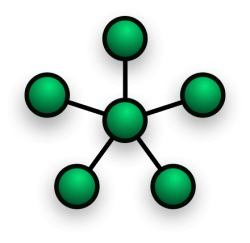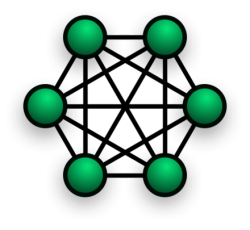You may have seen terms like “mesh network” and “power grid” but not paid much attention (or even knew their significance), but the ideas behind these terms are becoming very important in many diverse ways.
Whenever you connect things together, there are generally two ways to do it: in a centralized way, or in a distributed (decentralized) way:

Centralized network
For example, an airline might use a “hub and spoke” model for its flights, so in order to fly from one city to another you would typically fly to a central “hub” airport, and then take a second flight to your destination. Likewise, most people access the Internet through a centralized Internet Service Provider (ISP), so in order to send an email to someone in the house next to yours (or even to someone in the same house) the email travels to a central location (which might be hundreds or thousands of miles away) and then back to its destination. Another example is our power distribution system, where large centralized power plants distribute power to individual customers.

Distributed network
For example, some airlines avoid using hub airports, and instead try to have as many direct flights as is economically feasible. In a distributed power distribution system, instead of large centralized power plants you would have many smaller power generators, like solar panels on individual homes, or windmills. Distributed computer networks are commonly used inside of companies or buildings, so that individual computers can connect directly to other nearby computers without going through a centralized network router (and without leaving the building).
Why is this significant? It is all about control. When a network has to go through a central node, it is easier to control the network. Centralized networks are less robust — during hurricane Sandy, centralized networks (including cell phones and internet) failed but mesh networks were able to keep working because they didn’t have a single point of failure. But most worrisome, centralized networks are also easier to attack, since they have a single point of access. The NSA is able to spy on your phone calls and emails because these all go through centralized locations.
Indeed, the US State Department is worried enough about the insecurity of the Internet that it is spending millions of dollars helping people in other countries set up mesh networks, so that dissidents can communicate with each other without their government finding out. They provided $2.8 million to help set up a mesh network in Tunisia, and have pledged $4.3 million to set up another such network in Cuba. They are also helping set up similar networks in Asia and other places.
According to a former State Department official: “Exactly at the time that the N.S.A. was developing the technology that Snowden has disclosed, the State Department was funding some of the most powerful digital tools to protect freedom of expression around the world. It is in my mind one of the great, unreported ironies of the first Obama administration.”
Even more ironic are political attack ads, funded by the Koch brothers, anti-tax activist Grover Norquist, and big power companies. These ad campaigns in Kansas, North Carolina, Arizona and other states attack solar energy, in particular the policy found in dozens of states that guarantees homeowners and businesses with solar panels on their roofs the right to sell energy back into the power grid. In effect, this starts to convert our national power grid from a centralized network (large power stations sending power to individual consumers) into a mesh network.
A mesh network for power saves money, because power generation can be closer to power consumers (power doesn’t have to be transported as far, so there are fewer losses) and is more reliable. Solar power is especially good, since it generates more power when it is most needed — during hot sunny days when air conditioning is most used. Studies (especially those not funded by power companies) have shown that distributed solar generation like this actually saves power companies money.
But the power companies want to charge individuals for access to their power grid, as much as $100/month. This would destroy solar power.
You would think that self-proclaimed staunch libertarians like the Koch brothers would be all in favor of mesh networks, which favor individualism and individual control over collectivism and large centralized control. But instead they are spending lots of money trying to kill it. Maybe we should start calling them LINOs (Libertarians In Name Only), but a simpler term would just be “hypocrites”.
UPDATE: NY Times has an editorial about The Koch Attack on Solar Energy.
Or as Daily Kos puts it:
The Koch Brothers are frequently described librertarian, but they want us all to be dependent on their dirty fossil fuel. They don’t care about anyone’s liberty but their own. They want to have the government to use eminent domain to take the land of ranchers and farmers to build Keystone XL to ship their dirty tar sands oil to Texas for refining and export. And they are demanding that the government taxes the sun.


4 Comments
I think it’s save to say that “individualism” is just another dog whistle term for some on the right. They don’t actually care what anyone else’s rights are until it conflicts with/furthers their own agendas.
To add to the irony in US policy on the internet, it now seems like the FCC is falling over itself trying to help Comcast and the other cable giants charge consumers more for slower (compared internationally) access to less content.
More irony… IK, wasn’t the original, pre-PC internet a mesh network — and designed that way specifically because of its resilience?
Since I moved here 40 years ago, I’ve worked for independence. Then, getting older, I got propane to heat with and ran into “We don’t have enough, we’ll just let you run out of heat.” So I got infrared heaters that run off my generator if we loss electricity or propane. And of course, my little bit of solar which powers my smart phone and modem and light.
There are ways around the dependence on the grid.
On a well, I have a cord to run from the generator to pump to get water. (and lots of extension cords to run from my generator)
I’d better mention my good neighbors who will get gas for the generator for me.
Don’t mesh with Texas.